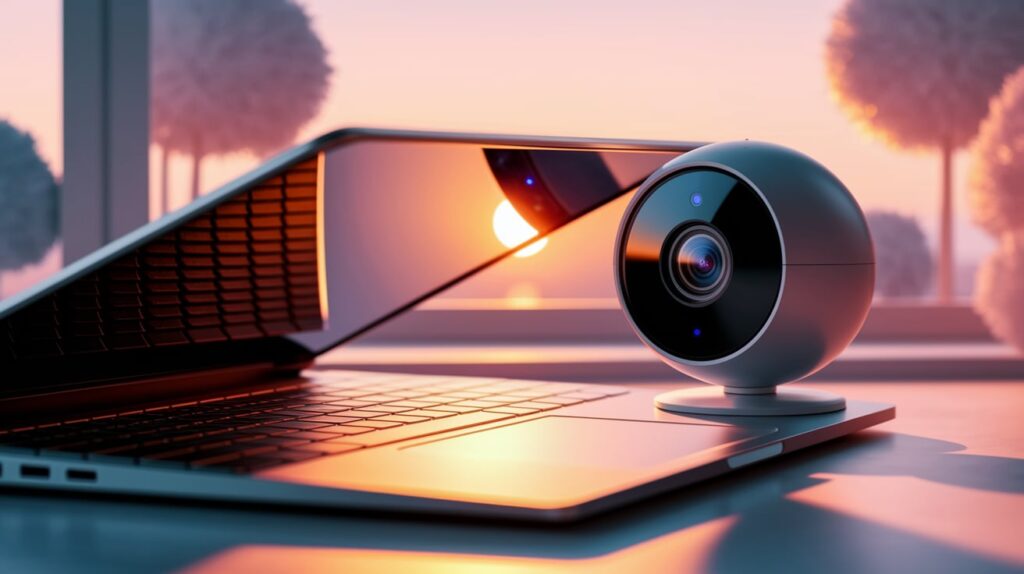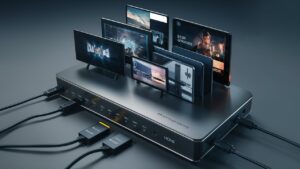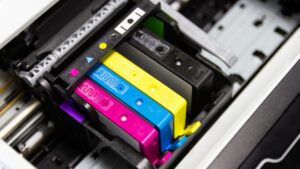Have you ever wondered how the small device sitting atop your computer screen works its magic? You’re not alone.
Understanding how webcams work can give you a new perspective on the technology that connects you to friends, family, and colleagues around the world. Imagine the clarity of video calls, the ease of virtual meetings, and the security of home surveillance—all thanks to webcams.
As you dive deeper into this article, you’ll discover the simple yet fascinating mechanics behind these indispensable gadgets. Picture yourself mastering the basics of webcam functionality and appreciating the technology that simplifies your digital life. Ready to uncover the secrets of webcams and make the most out of yours? Let’s explore together!
History Of Webcams
Webcams have become essential in our digital lives. They connect us in real-time, bridging distances and enhancing communication. Understanding their history can offer insights into their evolution and impact.
Early Days Of Webcams
The concept of webcams began in the early 1990s. Researchers at Cambridge University created the first webcam. It was used to monitor a coffee pot. This innovation marked the start of real-time video transmission.
Commercial Availability
By the mid-1990s, webcams entered the consumer market. They gained popularity as internet access expanded. Companies started producing webcams for personal computers. These devices offered low-resolution images but were revolutionary at the time.
Advancements In Technology
Webcams improved significantly in the 2000s. High-definition cameras became standard. Features like autofocus and face tracking enhanced user experience. These advancements made webcams more versatile and reliable.
Integration Into Everyday Devices
Modern webcams are integrated into laptops and smartphones. They offer seamless video communication. This integration made video calling accessible to everyone. It transformed how we connect with others.
Impact On Society
Webcams have changed our interaction with the world. They’ve impacted education, business, and personal communication. Their presence in daily life continues to grow. Understanding their history helps appreciate their role today.
Basic Components
Understanding how a webcam works begins with its basic components. These components determine the webcam’s quality and functionality. They play a crucial role in capturing and transmitting images and sound.
Lens And Sensor
The lens and sensor are key parts of a webcam. The lens captures light from the surroundings. It focuses this light onto the sensor. The sensor then converts the light into digital signals. This conversion creates the image you see on your screen. Better lenses and sensors produce clearer images. They also work better in low light conditions.
Microprocessor
The microprocessor acts like the brain of the webcam. It processes the digital signals from the sensor. It also manages the image compression. This makes it easier to send images over the internet. The microprocessor ensures smooth and fast video streaming. It also helps in reducing lag during video calls.
Microphone
The microphone is often built into the webcam. It captures sound from the environment. The microphone converts sound waves into digital audio signals. Good microphones can pick up clear audio even from a distance. This is crucial for video calls and recordings. Clear audio enhances communication and understanding.
Image Capture Process
The image capture process in a webcam is fascinating. It transforms light into digital data. This process allows us to see and share images online.
Light To Digital Conversion
Webcams start by capturing light. The lens collects light from the scene. Then, this light hits the sensor. The sensor is a key component. It converts light into electrical signals. Most webcams use a CMOS sensor. This sensor is efficient and compact. It captures light quickly, turning it into data.
Image Processing
Once the light is digital data, it needs processing. Image processing improves picture quality. It enhances colors and sharpness. The webcam has built-in software for this. It processes each frame rapidly. This ensures clear and crisp images. The processed image is ready to display. Then, it can be sent to your computer. You see real-time images on your screen.
Video Transmission
Webcams capture images using a tiny camera sensor and transmit them through video signals to your computer. This digital data is processed, allowing real-time video communication. Through software, webcams adjust settings like brightness and contrast for clearer images during video calls.
Video transmission is the heartbeat of how a webcam works, turning live action into a digital format that can be seen anywhere in the world. Imagine chatting with a friend across continents, and how your webcam captures your expressions, sending them in real time. This process involves converting visual data into signals that travel through USB connections or wirelessly. But have you ever wondered how these signals make the journey from your device to another?
Usb Connection
Webcams often connect to computers using USB cables, a familiar sight for most of us. This method ensures a stable and fast transmission of video data. The USB connection allows your webcam to draw power from your computer, making it a plug-and-play device.
Think about how you simply plug the webcam into a USB port and start using it without any hassle. This straightforward setup is ideal for those who prioritize reliability and ease of use. It’s like having a direct highway for your video, ensuring smooth and uninterrupted communication.
Wireless Options
For those seeking flexibility, wireless webcams offer exciting possibilities. These devices connect to your computer via Wi-Fi or Bluetooth, removing the need for cables. This means you can position the webcam anywhere within range, giving you freedom to move around.
Imagine setting up a wireless webcam in your living room to monitor your pet while you’re at work. The video streams seamlessly to your device, offering peace of mind and a glimpse into your furry friend’s day. However, consider if your Wi-Fi network is strong enough to support this option, as a weak signal can lead to choppy video quality.
In choosing between USB and wireless, think about your needs and environment. Do you prefer the reliability of a wired connection, or is the flexibility of wireless more appealing? Each option has its unique benefits, designed to cater to diverse user preferences. As technology evolves, these video transmission methods continue to improve, offering even more efficient ways to stay connected.
Resolution And Quality
Webcams have become essential for communication and content creation. One of the key factors that determine their effectiveness is resolution and quality. These elements define how clear and detailed the captured images and videos are. Understanding resolution and quality helps in choosing the right webcam for your needs.
Pixels And Megapixels
Resolution is measured in pixels. Pixels are tiny dots that make up an image. The more pixels there are, the clearer the image. Megapixels refer to a million pixels. A webcam with higher megapixels captures more detail. This results in sharper images and videos. Most webcams range from 1 to 8 megapixels. Higher megapixels mean better clarity but can increase the cost.
Frame Rate
Frame rate refers to the number of frames captured per second. It is measured in frames per second (fps). A higher frame rate ensures smoother video playback. Common frame rates for webcams are 30 fps and 60 fps. 30 fps is standard for regular use. 60 fps offers a more fluid experience, ideal for gaming or streaming. Selecting a webcam with an appropriate frame rate improves video quality.
Autofocus And Zoom
Webcams have become essential in our digital world. They allow us to connect virtually. Autofocus and zoom features enhance this experience. They ensure the best image quality. Whether for video calls or streaming, these features are crucial. Let’s explore how they work.
Fixed Vs. Autofocus
Webcams with fixed focus have a set lens position. They work best at a specific distance. This type is simple and cost-effective. Autofocus webcams adjust their lens for clarity. They detect the subject’s distance. Then they adjust the lens position automatically. This feature ensures sharp images at varying distances. It’s ideal for users who move during video calls.
Digital Zoom
Digital zoom is a common feature in webcams. It enlarges the image digitally. Unlike optical zoom, it doesn’t involve lens movement. Instead, it crops and enlarges the image. This can reduce image quality. The benefit is flexibility. Users can focus on specific areas without moving the camera. This is useful for presentations or focusing on details. Remember, excessive zooming can blur the image. So, use it wisely for best results.
Lighting And Exposure
Lighting and exposure play a key role in webcam performance. Proper lighting enhances video quality, making images clearer and more vibrant. Without correct exposure, videos can appear dark or washed out. Webcams have features to adjust to different lighting conditions, ensuring better visibility.
Automatic Light Adjustment
Most webcams come with automatic light adjustment. This feature detects surrounding light and modifies exposure settings automatically. It ensures the subject is well-lit, even in changing light conditions. This function is helpful in dim or overly bright environments. It balances light to reduce shadows and glare.
Manual Controls
Some webcams offer manual controls for advanced users. These controls let you tweak exposure settings manually. You can adjust brightness, contrast, and white balance. This feature is useful if automatic settings do not satisfy your needs. It gives you more flexibility to achieve the desired video quality.
Privacy And Security
Webcams are essential for communication, but they pose privacy risks. Unauthorized access can lead to spying or data theft. Understanding privacy and security measures helps prevent such threats.
Built-in Covers
Many webcams have built-in covers. These covers block the camera when not in use. They provide a physical barrier against unwanted access. Sliding the cover ensures privacy instantly.
Software Protections
Webcam software offers security features. These include access permissions and alerts. Permissions restrict who can use the camera. Alerts notify you of unauthorized access attempts.
Regular software updates enhance security. Updates fix vulnerabilities and improve protections. Setting strong passwords adds another layer of defense.
Innovations And Future Trends
Webcams have evolved significantly over the years. They are not just simple cameras anymore. Innovations and future trends show promising changes. These changes will make webcams smarter and more connected.
Ai And Machine Learning
Artificial Intelligence (AI) is shaping the future of webcams. AI can improve image quality. It does this by analyzing and adjusting video settings automatically. Machine learning helps webcams recognize faces. This technology can identify people and track movements. AI can also enhance security features. It alerts users of unusual activities. Smart webcams are becoming more common. They are used in homes and businesses for surveillance.
Enhanced Connectivity
Webcams now connect better with other devices. Enhanced connectivity allows seamless integration with smartphones and computers. Users can control webcams remotely. This feature is useful for home monitoring. Improved connectivity ensures better video streaming. It reduces lag and buffering during calls. Webcams can connect to the Internet of Things (IoT). This allows interaction with smart home systems. It creates a unified and connected environment. Enhanced connectivity makes communication easier and more reliable.

Frequently Asked Questions
Can Someone Watch You On Webcam?
Yes, hackers can access webcams if devices lack proper security. Use strong passwords and updated antivirus software. Cover your webcam when not in use for added safety. Stay vigilant against suspicious emails or downloads to protect your privacy. Regularly check for unauthorized access on your devices.
How Does A Webcam Operate?
A webcam captures video through a lens and converts it into digital signals. It connects to a computer via USB or built-in connections. Software processes the video for applications like streaming or video calls. Built-in microphones often accompany webcams for audio input.
Does The Webcam Connect To The Monitor Or Computer?
The webcam typically connects to a computer via a USB port. Some monitors have built-in webcams. Always check the device specifications to ensure compatibility.
Does A Webcam Need Internet?
A webcam doesn’t need the internet for local use, like recording or video calls on the same network. For online activities like video conferencing or streaming, an internet connection is required.
Conclusion
Webcams make online communication easy and fun. They capture images and videos. Light enters the lens, reaching a sensor. This converts light to digital data. Software processes this data. Your computer then displays the image on the screen. Webcams also have microphones.
This lets you hear the other person. They are important for video calls, streaming, and online classes. Understanding how they work helps in using them better. So next time, you can adjust settings confidently. Webcams are a great tool for connecting with others.
Simple yet effective technology at your fingertips.








